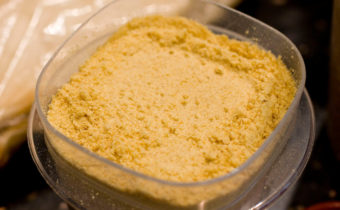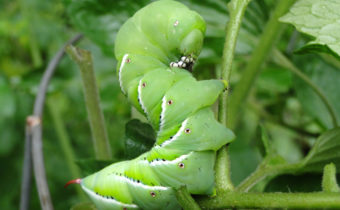How to deal with a garden scoop on tomatoes?
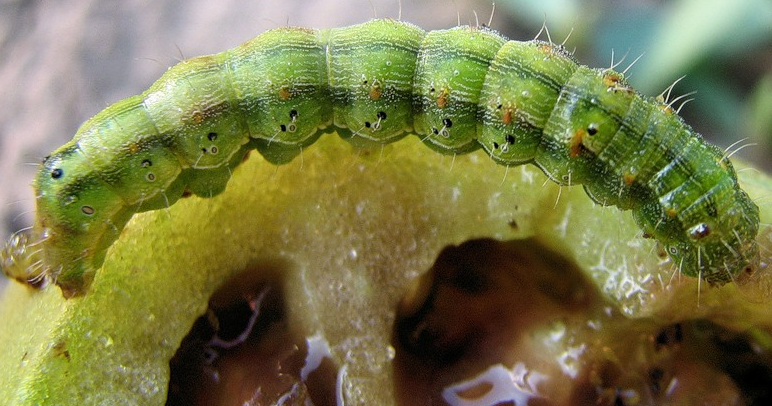
Caterpillars of the garden scoop feed on tomato leaves, weakening the plants, which negatively affects the formation of ovaries and fruits. The pest also causes direct damage to the crop by eating the flesh of the fruit. Damaged tomatoes scoop fall from the bushes, not having time to reach ripeness.
The insect can attack other garden crops, such as potatoes, eggplants, peppers, but tomatoes, as a favorite food of the pest, are threatened in the first place.
Pest characteristic
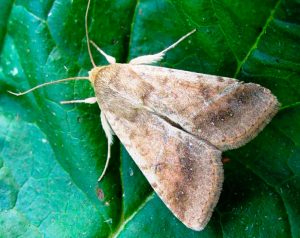 The adult individual of the scoop is a brown-gray butterfly, whose length is 1 cm, and the width of the wings is 3-4.5 cm. On the front pair of insect wings, specks can be discerned, the back pair is decorated with a dark border and has a lighter color.
The adult individual of the scoop is a brown-gray butterfly, whose length is 1 cm, and the width of the wings is 3-4.5 cm. On the front pair of insect wings, specks can be discerned, the back pair is decorated with a dark border and has a lighter color.
The years scoop begins in May and lasts until the end of July. Butterflies lay yellow eggs, not more than 0.5 mm in diameter, attaching them to the back of the leaves. Caterpillars have a green or brown color, can reach 3 cm in length. They feed at night, during the day they hide in the soil. In winter, the caterpillars go to the ground, able to withstand temperatures up to -10 ° C. Pupation occurs in the spring.
The pupae are brown in color and about 2 cm in length. The process of pupation lasts 30-40 days, but in the warm season this period can be reduced to 18 days. If the caterpillar gets enough food, it is able to go into the pupal phase already in the middle of summer. Thus, in the southern regions, 2 generations of pests can be released during the season.
Adults, like caterpillars, are nocturnal. To detect pests before they cause serious damage to the planting of tomatoes, it is necessary to leave traps at the site for the night from time to time. If in the morning they get butterflies, it is urgent to take measures of protection.
Fighting caterpillar scoops
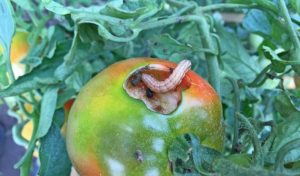
Part of the caterpillars can be collected by hand, finding them in the ground when loosening. It is desirable to combine the procedure of mechanical removal of pests with the use of biological and folk remedies. But a significant defeat landing scoop requires processing chemicals.
Chemicals
Of the chemical preparations against scoop effective:
- organophosphate pesticides - “Fufanon”, “Zolon”, “Danadim”, “Dursban”;
- synthetic pyrethroids - Kinmiks, Fury, Karate Zeon, Arrivo, Detsis Profi, Shtefesin, Zeta-cypermethrin, Inta-Vir;
- neonicotinoids - Aktara, Confidor, Proteus (also contains pyrethroid deltamethrin).
Pyrethroids have a large insecticidal effect in comparison with organophosphorus compounds, accumulate mainly in the surface plant tissues, therefore, are faster displayed, not concentrating in the fruit. In addition, these substances decompose faster, polluting the environment to a lesser extent, and are harmless to beneficial insects.
Neonicotinoids are less toxic in comparison with organophosphate pesticides, are able to penetrate into all parts of the plant, but they are dangerous for beneficial insects, in particular, for bees. Spraying preparations should not be carried out during the flowering period of tomatoes.
Biological protection
Biological agents acting against scoops may contain:
- plant toxins;
- waste of bacteria and fungi, affecting the nervous and digestive system of caterpillars;
- bacteria and fungi that parasitize on scoops.
All these tools are safe for humans, but they destroy pests well. To remove the caterpillar scoops from planting tomatoes, recommended drugs such as "Fitoverm", "Dendrobatsillin", "Akarin", "Bitoksibatsillin", "Actofit", "Entobakterin", "Lepidotsid".
Folk recipes
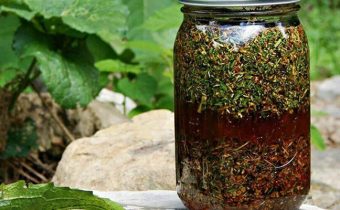
Most of the folk remedies do not destroy, but frighten caterpillars and butterflies from plants, therefore, for a sustainable effect, they should be processed several times per season. In addition, folk recipes are suitable for the prevention of scoops.
- Sagebrush. Fresh stems and leaves should be chopped and filled with water at the rate of 3 kg per 10 liters, bring to a boil and leave for 20 minutes. Sprayed tomatoes immediately after cooling broth.
- Mustard powder. In a liter of water it is required to dilute 50 g of mustard and boil the solution for 10-15 minutes. Insist 24 hours. Before spraying, 1 part of the product should be diluted with 20 parts of water.
- Red (bitter) pepper. Take 1 kg of fresh fruits of red pepper (you can use dried fruits or powder, in this case, you will need 500 g) and pour 10 liters of water. After boiling the broth for 60 minutes, leave to infuse for a day. Before spraying the planting of tomatoes should be diluted 10 liters of funds 70-80 liters of water.
- Burdock The green parts of the plant are crushed and filled them with a bucket to the top, then pour water. Insist for 2-3 days, covered with a lid.
- Arrows of garlic. Infusion is prepared similarly to the means of burdock, but you need to insist on a sunny place, stirring occasionally to activate the fermentation processes during the week. Ready infusion diluted with 10 parts of water. Spraying is carried out every 2 weeks.
- Garlic. 20 g of garlic teeth need to be crushed (to enhance the effect, you can add 20 g of tobacco powder and 10-20 g of onion peel) and, pour liter of warm water, boil for an hour. Before using the broth is diluted with 5 liters of water.
- Bow. 70-80 g of onion peel or 350 g of chopped onion pulp pour 10 liters of water and leave for 12 hours.
If the procedure of spraying tomatoes is carried out before flowering, it is advised to add 20 g of ammonium nitrate to the bucket of the finished infusion or decoction, combining the treatment against the pest with nitrogen fertilizer and strengthening the effect of the product.
- Potassium permanganate. Planting tomatoes sprayed with a pale pink solution of potassium permanganate.
- Wood ash. 500 g of ash poured a bucket of cold water. Add shavings from 1/10 of the bar of laundry soap. Ash can be applied in a dry form for dusting tomatoes by mixing in equal parts with tobacco powder and lime.
Fighting butterflies and larvae scoops
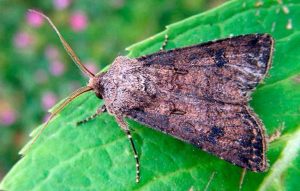
Work on the scoop should not be limited to the destruction of caterpillars, it is necessary to take measures against adult butterflies and pupae. Only a complex effect against the pest at all stages of development can completely expel the insect from the site.
Fighting an adult
When scoops are found on the butterflies site, the gardener's task is not to allow the insect to lay eggs on plantings. To do this, use:
- Traps. Butterflies are lured to fermented drinks (beer, kvass, syrups, juices), with which containers are placed on the site.
- Breeding predatory insects feeding on a scoop. These include trichogramma, brakon. You can purchase such assistants on special farms.
- Scaring. If you want to quickly respond to the appearance of scoops, you can scatter the egg shells between the rows. Planning protection in advance, it is worth planting plants near the planting of tomatoes and other potentially vulnerable crops, the smell of which deters the pest. This is cilantro, basil, calendula.
- Processing infusion.Folk remedies, especially those with pronounced aroma (infusion from onions or onion peels, teeth or arrows of garlic, mustard powder, powder from tobacco powder), will also scare the butterfly away from planting.
Destruction of the larvae
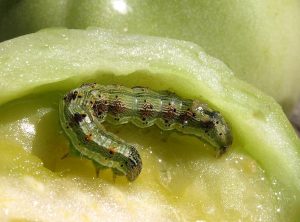
The larvae of the scoops are quite large, so part of them can be collected by hands when digging the area. But to completely choose insects, especially with a large landing, is impossible. It is necessary to resort to additional methods of struggle:
- The rise of the lower layers of soil. After harvesting, dig the plot deep. It is necessary to turn the layers of soil at a depth of 25-30 cm - most pupae hiding at this level and die from the cold, being on the surface. The same procedure is repeated in early spring to destroy the pests that survived the winter.
- Attraction of birds. The scoop of tits, flycatchers and sparrows eagerly eat the larvae.
- Chemical soil treatment. Use insecticides against soil pests. Among the most effective otkovki gardeners call "Basudin."
Prevention
Many pests, including the scoop, gardeners, as a rule, notice when the insect population in the area becomes large, because of which the fight against them becomes a difficult task. Regular preventive measures suppress the spread of parasites at the onset of a lesion or restrain their numbers at a low level.
Against scoops effectively:
- Weed removal. Scoops lay eggs on the leaves of not only cultivated, but also of weeds. In addition, at the beginning of the growing season, when there is still little food, the caterpillars can eat weeds. Flowering weeds are especially dangerous because they attract butterflies. In view of this, weeds should be weed out and burned. Garden scoop, which affects tomatoes, especially loves quinoa, nettles and grass weeds.
- Frequent loosening. This procedure, useful in itself for tomatoes, is also effective in the fight against the scoop - it will help to raise the caterpillars hidden from the sun to the surface of the ground, which will lead to their death.
- Autumn cleaning. The remains of tops or weeds in the area provide additional protection for wintering caterpillars. Careful cleaning and digging the site will significantly reduce the pest population.
- Proper site planning. It is not necessary to plant near the tomato most preferred pest cultures - potatoes, bell peppers, beans, potatoes, eggplant, corn. But planting between the rows of scaring shovels of plants will be an excellent protection against butterflies.
Measures to prevent the appearance of scoops are useful as a preventive measure for some other pests (for example, whitefly, spider mites), as well as fungal diseases. The same applies to folk remedies, the processing of which will not be superfluous even with the apparent absence of pests. At the first signs of tomato damage with a scoop, it is worth trying to solve the problem with biological means and agrotechnical methods, leaving “chemistry” for exceptional cases.


